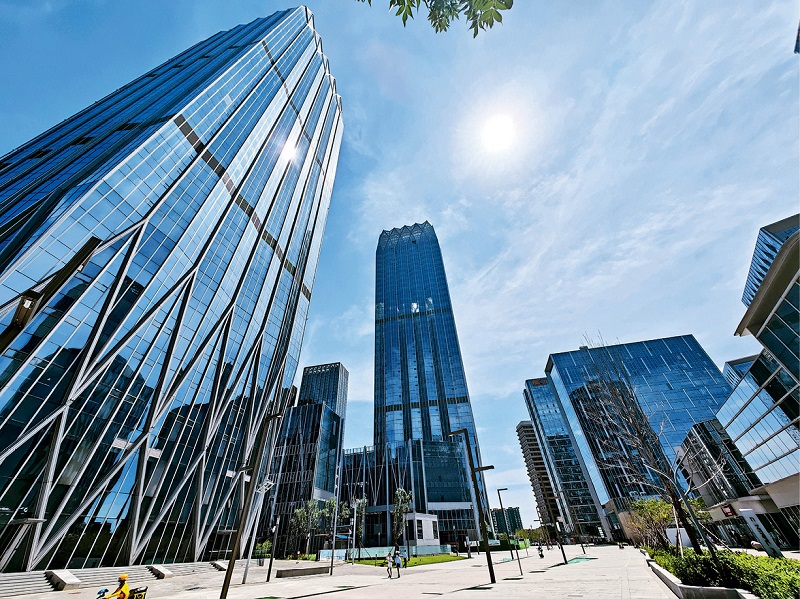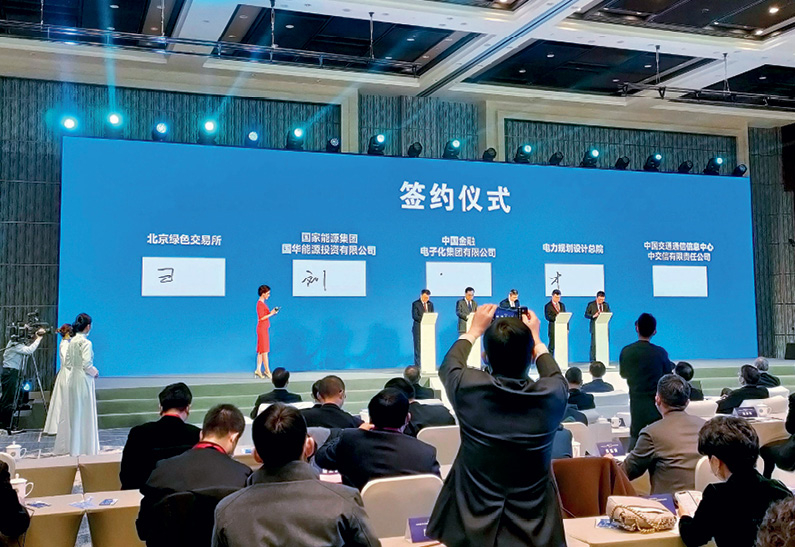Financing a Green Future
Green finance is the key to making industries more environmentally friendly.
At the intersection of five rivers where the Beijing-Hangzhou Grand Canal starts and the Canal Business District (CBD) is located, the landmark ArtPark9 Twin Towers bask in the morning light. There are people exercising on the waterfront trail while egrets and silver gulls gracefully glide across the water, and a canopied boat passes by, picking up floating debris.
In recent years, the CBD, the main area for finance, business services, and media in Beijing’s administrative center, has seen its water environment improve remarkably and a green city emerging, ready for high-quality development.

The landmark ArtPark9 Twin Towers are located at the Canal Business District.
A Greener CBD
The dock at the intersection of the five rivers gained fame 600 years ago during the Ming Dynasty (1368-1644). It was here where millions of tons of military rations were transported from southern China every year to the then Beijing. Later in the Qing Dynasty (1644-1911), there were nearly 300 financial institutions located around the dock, including the branches of some private banks.
“The CBD has a long history as a regional financial center,” Lin Zhenghang told China Today. Lin is the director of the CBD’s management committee as well as director of Tongzhou park of Zhongguancun Science Park, Beijing’s technology hub.
The CBD focuses on the key industries of headquarters economy, wealth management, green finance, and financial technology. The high-value financial sector is thriving again. The wealth management departments of the Industrial and Commercial Bank of China, Bank of China, and Bank of Beijing have their headquarters here.
Lin says over 20,000 enterprises registered at the CBD due to the green ecology and enabling business environment.
“Green finance” is the most promising and distinctive sector in the CBD, representing the philosophy of sustainable development and supporting environmental protection through investment and financing, as well as financial product innovation.
During the 14th Five-Year Plan period (2021-2025), a national green finance reform and innovation demonstration zone will be built at the CBD. The aim is to have more than 100 fintech companies, over 10 green financial institutions, and 200-plus wealth management institutions by 2025, with green credit exceeding RMB 20 billion (US $2.7 billion). The target for cumulative transactions of carbon quotas and voluntary emission reductions is over 100 million tons.
The relocation of the China Beijing Green Exchange (CBGEX), a market platform that integrates various environmental trading services, from downtown to the CBD is a boost for the latter.
“It is highly consistent with our development strategy of attracting innovative enterprises and the headquarters of multinational corporations,” Lin said. “We are confident that more and more enterprises, research institutions, and investment organizations related to green industries will come to the CBD.”

The China Beijing Green Exchange (CBGEX) officially reopens at the CBD on February 4, 2023, speeding up the process of building a national green finance reform and innovation demonstration zone.
Driving Sustainability
“Green development is our guiding principle,” Lin said. The CBD provides strong policy support and a superior market environment for the development of green finance. In 2021, the State Council issued a document on supporting high-quality development of Beijing’s administrative center, with measures such as accelerating the development of green finance and building a sustainable financial center.
There is a large demand for funds and financial services during the construction of Beijing’s administrative center, which has created a gigantic market for green finance. Lin said the government is guiding financial resources into green and low-carbon fields, supporting new technologies, products, and green transition of the real economy. They are also geared toward meeting the new demand of society for green products, green consumption, and a green lifestyle.
For example, the integrated development of the water environment and the city is a major feature of the CBD, and the water projects require a large amount of money. The CBD green branch in Tongzhou is providing financing for several water environment projects. The green branch is the first financial institution in China to get the “green network” service certification this year. The “green network” refers to reducing carbon emissions during banks’ activities, such as construction, decoration, and business services to achieve carbon neutrality.

Local residents are enjoying water sports on the Grand Canal.
ESG Creates Value
Industries thrive with the development of a city, and the city thrives due to booming industries. Following the State Council document, a three-year action plan (2023-2025) was drafted for the development of the CBD. It seeks to enhance businesses’ environmental, social, and governance (ESG) performance and accelerate the formation of a green financial standard system to build a solid base for the green industry in the CBD.
ESG is a framework that helps stakeholders understand how an organization is managing risks and opportunities related to environmental, social, and governance criteria, known as ESG factors. It is an important indicator for evaluating the contribution of enterprises in promoting sustainable growth and fulfilling social responsibility. It now plays a major role in investment decision-making in the global capital market, which perfectly matches the green and low-carbon industry in the CBD.
“We launched the first city-level ESG research, production and investment integration platform in China – the ESG Green Industry Innovation Center – in 2022 to accelerate the overall industrial chain, build a nationally leading ESG development model, implement ESG digital applications, and advance the green transition of the municipal administrative center,” Lin said.
Leading green finance institutions like the Institute of Finance and Sustainability, China-U.S. Green Fund and China-Europe Green and Innovation Industry Association have their presence in the CBD. Among them, the China Three Gorges Renewables listed on the Shanghai Stock Exchange is the first green listed company based in the administrative center. Its market value crossed RMB 100 million (US $13.9 million) on the first day of listing.
“From the introduction of the ESG concept to its implementation, the whole industrial chain has become the most critical driving force, with entities, finance, research, and carbon emission trading. An agglomeration effect has emerged,” Lin said.
He also shared some key statistics: The green industry has witnessed the issuing of green loans valuing more than RMB 10 billion (US $1.3 billion), and the balance of green credit reaching nearly RMB 27 billion (US $3.7 billion), accounting for more than 10 percent of the total loans within the region. The carbon quota and trading market has covered approximately 1,400 key emission units, with a total transaction volume exceeding 98 million tons and the turnover surpassing RMB 3.4 billion (US $474 million).
The China Securities Regulatory Commission and People’s Bank of China have released a national system of green finance standards. Moreover, the green identification methods for project financing and enterprise financing drafted by the CBGEX provide standard guidance for the construction of green project libraries and following up on climate investment and financing tools.
“ESG has become a widely recognized standard. We will provide ESG consulting services to centrally-administered and state-owned enterprises and hope to attract more ESG service enterprises to jointly build the national green development demonstration zone,” Lin said. His vision is of a vibrant green new city emerging alongside the ancient Grand Canal.
blog comments powered by